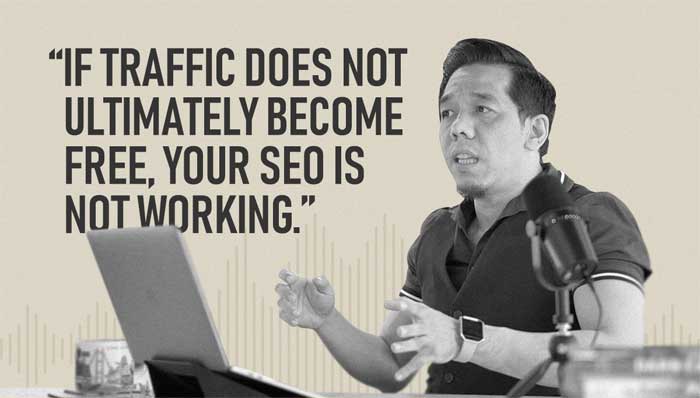There’s 200 Google Ranking Factors And 10 To Remember

There are over 200 Google ranking factors and this can be accounted to Google being the most popular search engine on the planet. Compared to other search engines, there is an average of over 5.14 billion searches taking place on Google each day. And with algorithm changing constantly and similar sites implementing their own optimization strategies, it can be hard to keep up with all the changes and compete at the same time.
There are 200 factors to consider, but to begin with, it’s best to keep track of this 10:
1. High-Quality Content
If content is king, then Google ranking factors is definitely one as well. Creating a unique and fresh content that relates to the market will result to a higher rank on its search engine page results (SERPs). Content Marketing is one of the most important cornerstones of a successful digital marketing strategy. Without it, it is not possible to populate a website; create posts for social media; or send email to loyal subscribers looking for some relatable updates
Google pays special attention to content quality through the following:
Original, Unique, and Valuable Content
Google gives preference to content that’s new and unique through created posts that answer the reader’s questions, provides value, and is original.
If the content is similar to other webpages, then it would be a negative impact on its SEO. Also, if there is duplicate content, Google will slow down the crawling rate of the website.
Up to Date and Fresh Content
Another way to boost content quality is by keeping it fresh and updated. By regularly updating posts and adding new information, it is sending a positive signal to the search engine.
Content freshness plays a big role when it covers topics that involve news or trends, and Google prefers pages that provide the latest information.
For instance, when writing about the global health crisis, it will want the content to contain recent news items and researches.
A simple way to finding the latest information and keep content fresh is by using Google Trends. Just enter the search term in the tool and look at Related Topics. These are trending queries that can help add value to the posts.
Content-Length
Studies show that content length has an impact on where it ranks on the search results, and posts with 1,890 words on average ranks on the first page.
However, instead of word counting, there’s a better way of looking at this. Create content that has depth and covers a topic in great detail. Consider the search intent and the answers to the most common queries. Google prefers pages that fully answer a user’s question and provides detailed solutions.
Content Structure and Organization
When it comes to content quality, the blog posts should be well organized and structured. This makes it easier for the visitors to read the posts and easily find solutions to their problems.
By working on the content’s structure and organization, it’ll increase its readability. As a result, it’ll improve the user experience of the site, which indirectly improves the chances of ranking higher on Google.
Readability is closely related to growing your audience. If a well-structured and organized content is paired with a consistent delivery and effective interaction, people who enjoy interacting with the content will share it with others. Content that engages with audiences drives and grows traffic; if it is good with content, this user audience can turn into real customers.
2. Backlinks
Following content, another important Google ranking factor is backlinks. Content and backlinks go hand in hand as webpages without any backlinks hardly get any organic traffic – and this is how Google finds the website for indexing.
Backlinks or inbound links can be considered as a vote of confidence for the website. Google adds all those votes together and checks if the website deserves to rank in the top 10.
Receiving backlinks from high authority websites boosts the chances of higher rankings. By acquiring these links, it sends a signal to Google that the site’s content is trustworthy as different websites can vouch for it.
3. Search Intent
Another crucial ranking factor for Google is matching the search intent to the content. Search intent is basically what a user is looking for.
Businesses often ignore the recommendations of their SEO agency or web design services provider to preserve the “integrity” of their website, a.k.a. creative execution over-optimization. However, there is a middle ground and that is search intent, or understanding the “why” behind a search query.
Search intent also varies based on format and style. Google will serve top results in videos and infographics. To a brand, this means that you also need to create videos and infographics to rank for those important keywords.
Since 80% of the organic search traffic and performance will be driven by On-Page Strategies, consider the following:
- Changes to navigation
- URL customization
- Ability utilize the H1 for content
- Presence of the keyword and related ideas
- Ability to add new pages (to capture the right intent)
- Ability to add schema to enrich your search results
- Interlinking between your related pages
- Ability to track user interactions on your site
- Mixing and matching different content formats on your page, and;
- Willingness to let go of design elements or functionalities that don’t benefit users
Better On-Page means users and search engines are able to capture and understand the content, context and value the offer in a way that improves the experience of a user.
4. Website Loading Speed
Another factor to focus on is page speed. From May 2021, Google made website loading speed a part of its Core Web Vitals where looks at the speed, responsiveness, and how quickly elements like fonts and images load.
There are several ways to attack speed issues, but doing these create the most impact:
- optimizing font and image loading;
- reducing HTML, CSS, and Javascript files;
- enabling file compressions; and
- speeding up server response time
5. Mobile Friendliness
Ever since Google has gone mobile-first in 2019, it’s important that the website is optimized for mobile viewing and interactivity. this means that Google will focus on using the website’s mobile version for indexing and ranking.
In the past, Google would use the desktop as the primary version for indexing. But with 3.7 billion mobile internet users in the world, Google needed to be where the people spend most of their time on.
6. Domain Authority
The next Google ranking factor is your website’s domain authority (DA). It’s a ranking metric that shows the site’s expertise about a particular topic and its ability to rank on search engines. It assigns a website a score between 1 and 100, and the higher your site’s domain authority, the higher are the chances of ranking on Google.
This is where the need to create amazing industry-focused content is helpful. Publishing high-quality content about your industry increases your site’s topical authority. Google will start to recognize you as an expert on the topic, boost your domain authority, and rank the pages in the first page search results.
7. Keyword Optimization
Obviously.
To ensure that the website is keyword optimized, here are a few tips:
- Include keywords in Title Tags
- Meta Description – Write irresistible meta descriptionsand add a focus keyword so users know what page is about and click on it.
- Image Alt Text– Since Google cannot read images, add keywords in the image alt text section to tell what the visual is about.
- Anchor Text – Google uses anchor textto find out what’s the page about, so it can use keywords for anchor text when linking pages.
- Use LSI Keywords – Besides the primary keyword, there are other related terms that people search for and these are called LSI (latent semantic indexing) keywords. By including these on the page, it is helping Google figure out what’s the content about.
- Avoid Keyword Stuffing – Keyword optimization doesn’t mean only including the primary search term repeatedly, also known as keyword stuffing. This is NOT a good SEO practice. Try to include the head search term a few times and then mix things up with different word combinations.
- Include keywords in H2 and H3
- Add Keyword in URL
8. Website Structure
While keyword optimization is important, another factor that should looked into is the site’s structure, especially if it is just about to launch a website.
The website’s architecture is important from a crawling and indexing perspective. It allows Google crawlers to easily find the website and its pages.
To improve the site’s structure, start by creating a sitemap. A sitemap contains all the important pages that it wants the search engine to know about.
It helps Google crawler to easily navigate through the website, discover new content, and index the pages.
9. Website Security
Along with website architecture, site security is also a key Google ranking factor. It needs to ensure that the site is on HTTPS and encrypts the data between the website and the user’s browser.
Google confirmed in 2014 that HTTPS is a ranking signal, so if your site doesn’t have SSL certificates and is not on HTTPS, now would a good time to update.
10. User Experience
The last key important Google ranking factor to consider is the overall user experience of your website. Take off your business owner or manager hats and look at your site from your customer’s perspective, what kind of experience does it give? There are a lot of things that contribute towards a good user experience, and these are like signals to how Google ranks your site.
Some of them include your CTR (click-through-rate), bounce rate and dwell time.
If you want to check the rest of the other Google ranking factors, you can find them here.










